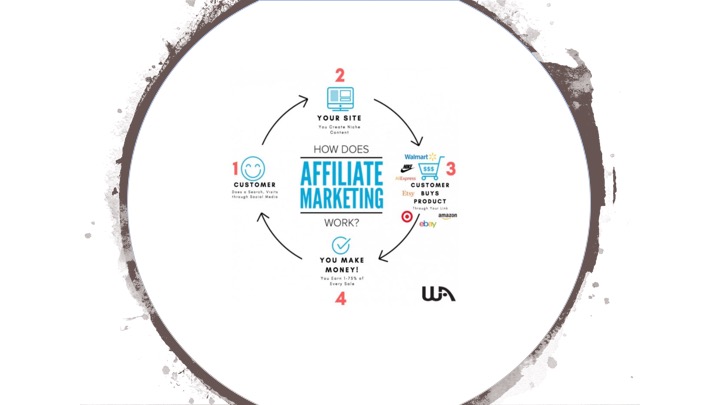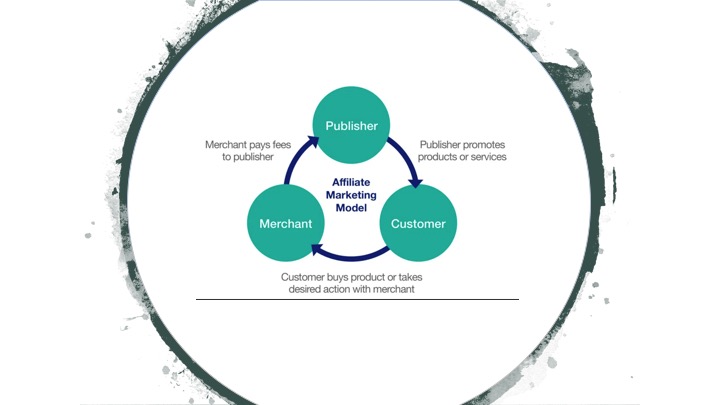- Part 1 – digital e-commerce models
- Part 2 – ecommerce is about connecting buyers and sellers – but how do you do that online?
- Part 3 – Can you build an online business based on marketing and which way did I choose to take my online business?

Word of mouth marketing (WOMM) or advocate marketing as it is sometimes called, plays a big part in our buying decisions. Check out this stat:

So much so that:
- In 2019 it was estimated that it drove $6 trillion of consumer spending for the year.
- It accounts for approximately 13% of consumer sales.
- Folks are 90% more likely to trust and buy a brand recommendation made by a friend.
- 88% of people place the highest level of trust in recommendations from people they know.
(sources include Linkedin, Forbes and Neilson)
You see we are wired to understand referrals. If you have a great experience using a product or service then it becomes part of your “story” and gets woven into the conversations you have with your friends and family. This is because the fabric of all of our meaningful conversations is the mutual sharing of our experiences.
However, what marketers have found is that while 83% of satisfied customers are willing to refer products and services only 29% actually do!!
So, we have a situation where people love a product or service, say they will tell others but, very few do.
Why?
Apparently, the main reason is that folks just forget. They get busy, life happens and they move on. It just slips their mind!
Trying to solve this problem has led to business trying to develop referral programs to incentivise satisfied customers to tell (refer) others. (referred customers) These programs make good sense to the sellers because:
- Referred customers are less likely to leave, making them more loyal to a brand.
- Referred customers bring higher profit margins (as high as 25%!)
However, referral programs still have their challenges and this has led to sellers trying to find other ways to “get the word out” in a manner that taps into all the best parts of WOMM.
Herald the rise of affiliate marketing and more recently, influencer marketing, both of which are really closely linked.
affiliate marketing
Affiliate marketing is part of the C2B digital e-commerce model, and is a model that allows brands to partner with individuals or companies (known as affiliates) to do a particular task for them, paying them after they have done the task.
The “task” will be something like selling products, increasing leads, or bringing in new customers, depending on the product or service being offered.
In many ways, affiliate marketing is a variation of the traditional sales model.
An affiliate introduces their online audience to products from companies. In return, they get a commission from any purchases their audience make.
While the picture below is simple it seems to me that this is pretty much what it’s all about:

source: affiliate market school
Affiliate marketing is built on transparency and partnerships. That is very similar to influencer marketing, which is built on trust and authenticity.
influencer marketing
According to Wikipedia, influencer marketing is:
“A form of marketing in which focus is placed on influential people rather than the target market as a whole. It identifies the individuals that have influence over potential buyers, and orients marketing activities around these influencers.”
Basically, influencers are people who have amassed a large audience, typically on social media channels like Instagram, Twitter or YouTube.
They can also be a blogger whose blog is read by millions of viewers each month. Alternatively, they may be known as “content creators”, because their primary purpose is to create social content for their followers to consume.
You may think that influencers only thrive in certain visual industries like beauty and travel, however you would be wrong. There are plenty of influencers excelling and succeeding in all sorts of niches and industries.
Here are some examples of influencers in different kinds of niches:
- Travel, e.g Beautiful Destinations, The Planet D
- Food, e.g DanielFoodDiary, Natasha Kravchuk
- Entertainment, e.g Ryan Higa, King Bach
- Fitness, e.g Cassey Ho, Emily Skye
- Gaming, e.g PewDiePie, Jacksepticeye
- Tech, e.g Robert Scoble, Lewis Hilsenteger
- Business, e.g Tim Ferriss, Gary Vaynerchuk
- Pets, e.g Grumpy Cat, Nala Cat
And that’s only the tip of the iceberg. Influencers are everywhere (some aren’t even human – go figure).
By definition, influencers have sufficiently high standing online that they can influence the behaviours of other people – particularly in the specific niche where they have made their name and built a reputation where they are trusted experts.
So, to be effective at WOMM I need to be an influencer and build a huge following, right?
Well no, it seems that there are different categories of influencers with the concept of WOMM sitting most easily in the “micro” and “nano” categories:
Mega – are the highest ranking category and they will typically have more than a million followers. They are often more famous then influential – think Will Smith, the Rock and other A and B-list celebrities. This means that the relationship with their followers is pretty removed and they might not necessarily be subject matter experts either on the product or service they are talking about.
Macro – are a notch down from mega-influencers. One way to identify a macro-influencer is by their follower count, which should fall somewhere between 100,000 and one million followers. Unlike most mega-influencers, macro-influencers usually gained fame through their presence on the internet either by vlogging, or by producing content that people want to engage with.
Micro – is someone who has between 1,000 to 100,000 followers. Micro-influencers focus on a specific niche or area and are generally regarded as an industry expert or topic specialist. “[Micro-influencers] have stronger relationships than a typical influencer. This is often driven by their perception as an opinion leader of [a] subject matter. A micro-influencer, as opposed to a celebrity (Mega) or regular (Macro) influencer, often has a very uniform audience,” Gil Eyal, CEO and founder of HYPR Brands said.
Nano – are a relatively new breed of influencer. They tend to have a smaller number of followers in comparison to micro-influencers, less than 1,000 followers. “[A nano-influencer is] someone who has influence within their community. John Huntinghouse, director of digital marketing at Epic Marketing said.
The idea behind nano-influencers is to get “regular everyday people” to influence a brand’s product or service to their friends and family.
Sound familiar – WOMM!!
Most of the time this is achieved through user-generated content that talks about their experience with the product or service.
Story telling!!
“but hey; this all just sounds like multi level marketing (MLM) to me?”
I am old enough to have had some interaction with some pretty infamous MLM schemes and personally, I’m not keen to get caught up in that.
More research followed and this is where I got too.
While this might not be a technically correct explanation, it gives a general overview of the difference between the two, which seems to me to be mainly based on who expends the effort and who gets paid for that effort:
What do affiliate / influencer marketers do?
- identify various products and services in their niche to recommend to others.
- create blogs and other forms of media about those products and services explaining their experience with the item.
- recommend those items to people.
- create a link between the potential buyer and the potential seller.
- earn a commission from the seller every time someone buys a product through their referral.

What do multi-level marketers do?
- buy products that they like at a discount for their upline.
- recommend those products to others (online and/or offline).
- sell those products to anyone who is keen to buy them.
- the commission associated with the product they have sold is then shared between them and their “upline” and the upline’s upline and so on (apparently, it can in some cases be unlimited).
- recruit and train a team of individuals to do promote those same products through presentations, workshops, run trade show or farmer’s market booths, build blogs, promote on social media, etc.
- earn a commission as an upline based on what each individual in their teams do.

source: LaConte Consulting provides a great explanation about MLM if you want to dig into this some more.
quick roundup
Affiliate / influencer marketing – A marketing arrangement where:
- an individual can create a relationship with any online retailer of their choice, and
- the online retailer pays a commission to the individual for traffic or sales generated from their referrals.
Multi-level marketing – A marketing arrangement where:
- an individual joins a team,
- to promote a group of predefined products or services,
- that everyone else in the team is also trying to promote and sell,
- paid a portion of any commission available on a sale, while
- others who have not done the work earn a portion of the same commission.
closing thoughts
By this point I was clear that I wanted an online business and that I wanted to focus on affiliate / influencer marketing, but how to choose?
Well, stick with me, because in my last post of this series I am going to take you through my thought processes, my final decision and why.
Enter your name and email below if you would this series as an eBook.
Take care and talk soon
Thrive; don’t just Survive with Janette
